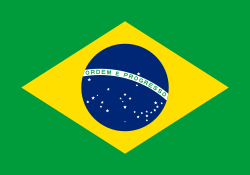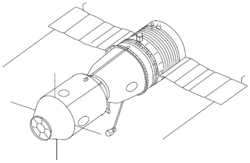Sojuz TMA-8
| Sojuz TMA-8 (Союз ТMA-8) | |||
| Beställare | Roskosmos | ||
|---|---|---|---|
| Modell | Sojuz-TMA | ||
| Tillverkare | RKK Energia | ||
| Operatör | Roskosmos | ||
| Anrop | Carat | ||
| Färdens tid | 182 dagar, 22 timmar, 43 minuter, 17 sekunder | ||
| Massa | 7 270 kg | ||
| NSSDC-ID | 2006-009A[1] | ||
| Uppskjutning | |||
| Startplats | LC1 Bajkonur | ||
| Start | 30 mars 2006, 02:30 UTC | ||
| Raket | Sojuz-FG | ||
| Landning | |||
| Landningsplats | 80 km NÖ om Arkalyk, Kazakstan | ||
| Landning | 29 september 2006, 01:13 UTC | ||
| Omloppsbana | |||
| Varv | 2 886 st[2] | ||
| Apogeum | 241 km | ||
| Perigeum | 200 km | ||
| Banlutning | 51,67° | ||
| Besättning | |||
| Start | Pavel Vinogradov (2) Jeffrey N. Williams (2) Marcos Pontes (1) | ||
| Landning | Pavel Vinogradov Jeffrey N. Williams Anousheh Ansari (1) | ||
 V-H: Pontes, Williams, Vinogradov | |||
| Dockning | |||
| Rymdstation | ISS | ||
| Dockning | 1 april 2006, 04:19 UTC | ||
| Port | Zarja, nadir | ||
| Ur dockning | 28 september 2006, 21:53 UTC | ||
| Kronologi | |||
| |||
Sojuz TMA-8 (ryska: Союз ТMA-8) var en flygning i det ryska rymdprogrammet. Flygningen gick till Internationella rymdstationen. Farkosten sköts upp från Kosmodromen i Bajkonur, med en Sojuz-FG-raket, den 30 mars 2006. Man dockade med rymdstationen den 1 april 2006.
Efter att ha tillbringat 182 dagar i rymden lämnade farkosten rymdstationen den 28 september 2006. Några timmar senare återinträdde den i jordens atmosfär och landade i Kazakstan.
I och med att farkosten lämnade rymdstationen var Expedition 13 avslutad.
Källor och referenser
- ^ ”NASA Space Science Data Coordinated Archive” (på engelska). NASA. https://nssdc.gsfc.nasa.gov/nmc/spacecraft/display.action?id=2006-009A. Läst 29 februari 2020.
- ^ Manned Astronautics - Figures & Facts Arkiverad 14 oktober 2015 hämtat från the Wayback Machine., läst 21 augusti 2016.
| |||||||||||||||||||||||||||||||||||||||||||||||||||||||||||||||||||||||||||||||||||||||||
| |||||||||||||||||||||||||||||||
| ||||||||||||||||||||||||||||||||
Media som används på denna webbplats
Flag of Iran. The tricolor flag was introduced in 1906, but after the Islamic Revolution of 1979 the Arabic words 'Allahu akbar' ('God is great'), written in the Kufic script of the Qur'an and repeated 22 times, were added to the red and green strips where they border the white central strip and in the middle is the emblem of Iran (which is a stylized Persian alphabet of the Arabic word Allah ("God")).
The official ISIRI standard (translation at FotW) gives two slightly different methods of construction for the flag: a compass-and-straightedge construction used for File:Flag of Iran (official).svg, and a "simplified" construction sheet with rational numbers used for this file.
Författare/Upphovsman: Pascal (Flickr user: pasukaru76), Licens: CC0
Vostok spacecraft replica at the Technik Museum Speyer, Germany.
Soyuz-TM spacecraft. Compare the antennas on the orbital module to those on Soyuz-T. Differences reflect the change from the Igla rendezvous system used on Soyuz-T to the Kurs rendezvous system used on Soyuz-TM.
In this illustration, a SpaceX Crew Dragon spacecraft approaches the International Space Station for docking. NASA is partnering with Boeing and SpaceX to build a new generation of human-rated spacecraft capable of taking astronauts to the station and expanding research opportunities in orbit. SpaceX's upcoming Demo-1 flight test is part of NASA’s Commercial Crew Transportation Capability contract with the goal of returning human spaceflight launch capabilities to the United States.
Apollo-Soyuz Test Project (ASTP) Soyuz. The APAS-75 docking unit is located at left.
The Soyuz TMA-04M spacecraft is seen after being rolled out by train to the launch pad at the Baikonur Cosmodrome in Kazakhstan, May 13, 2012. The launch of the Soyuz spacecraft, with Expedition 31 Soyuz Commander Gennady Padalka, Flight Engineer Sergei Revin of Russia and NASA Flight Engineer Joe Acaba, is scheduled for 9:01 a.m., May 15 (Kazakhstan time).
Backdropped by a blue and white Earth, this close-up view features the Soyuz TMA-6 spacecraft approaching the International Space Station (ISS). Onboard the spacecraft are cosmonaut Sergei K. Krikalev, Expedition 11 commander representing Russia's Federal Space Agency; astronaut John L. Phillips, NASA ISS science officer and flight engineer; and European Space Agency (ESA) astronaut Roberto Vittori of Italy. The Soyuz linked to the Pirs Docking Compartment at 9:20 p.m. (CDT) on April 16, 2005 as the two spacecraft flew over eastern Asia. The docking followed Friday’s launch from the Baikonur Cosmodrome in Kazakhstan.
Astronaut Marcos Pontes (left), Brazilian Space Agency’s Soyuz crew member, astronaut Jeffrey N. Williams (center), Expedition 13 NASA International Space Station science officer and flight engineer, and cosmonaut Pavel V. Vinogradov, Russia’s Federal Space Agency Expedition 13 commander, take a break from their training at the Cosmonaut Hotel in Baikonur, Kazakhstan, days before their launch on a Soyuz spacecraft.
Rotated and color enhanced version of original (ISS013-E-48788 (6 July 2006) --- The Space Shuttle Discovery approaches the International Space Station for docking but before the link-up occurred, the orbiter went through a series of inspection photos by station crew to inspect the vehicle for any damage to its Thermal Protection System. This was known as the Rendezvous Pitch Maneuver and was implemented after the Columbia Disaster in 2003. The Leonardo Multipurpose Logistics Module can be seen in the shuttle's cargo bay. Discovery docked at the station's Pressurized Mating Adapter 2 at 9:52 a.m. CDT, July 6, 2006.)
Soyuz-A manned spacecraft concept (1963). It was to have been part of the Soyuz A-B-C circumlunar complex.




















